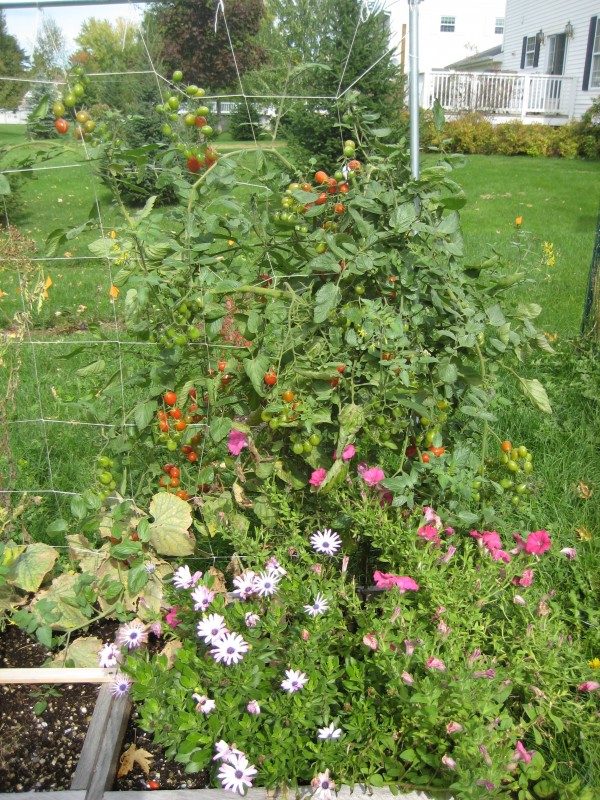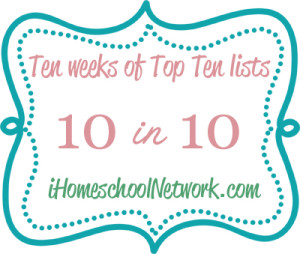 Hi, I'm Heidi and I homeschool my two sweet kids. I want them to know that learning is an exciting lifelong adventure! We love great books, unit studies, notebooking, lapbooking, and hands-on learning.
Hi, I'm Heidi and I homeschool my two sweet kids. I want them to know that learning is an exciting lifelong adventure! We love great books, unit studies, notebooking, lapbooking, and hands-on learning.The Reality of Homeschooling
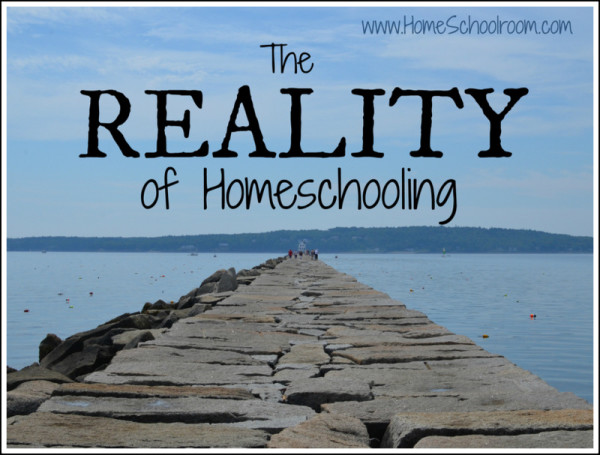
Once I got over the horror of the idea of homeschooling I read a lot of books and blogs and fell in love with the concept. I donned my rose-colored glasses and forged ahead with a plan to homeschool my children. I had visions of how it would go, formulated from heart-warming stories and lovely photos of this unique lifestyle.
Here are some of the dreamy myths I created in my head, and the real-life picture of homeschooling in our house:
Myth #1 The Warm Fuzzies of Homeschooling
I lived our days in my head many times as we finished up my daughter’s 2nd grade year in public school. I envisioned days spent curled up (by the fire in winter, on a blanket under a large shade tree in summer) with classic books, my children gazing at me with rapture as I imparted the wisdom of the ages. Our days would follow a warm and comforting pattern, without any of the frenzy of today’s world. Our house would be filled with gentle voices, loving embraces, and of course always be tidy. Laundry would never pile up and all our meals would be made from scratch.
The Cold, Hard Reality
- We do love books but I hardly think I’ve ever been the subject of a gaze of rapture. Sometimes their minds wander when I’m reading and I have to re-read a section.
- Homeschool families struggle like most do with keeping a sane schedule in this crazy-busy world. There are so many wonderful activities that keep us running (church, co-ops, classes and lessons) not to mention all the normal household errands that sometimes it’s harder than you think to schedule in the home part of homeschooling.
- Don’t get me going on the house! We are home much of the time, but often quite busy, so my house looks like a natural disaster scene more often than I’d like. The sheer amount of paraphernalia of homeschooling astounds me–microscopes and math manipulatives, paints and pencils, binders and books. I’ve had everything from caterpillars to chicken bones on my counter. As we move through subjects on a busy day my desk looks like this:
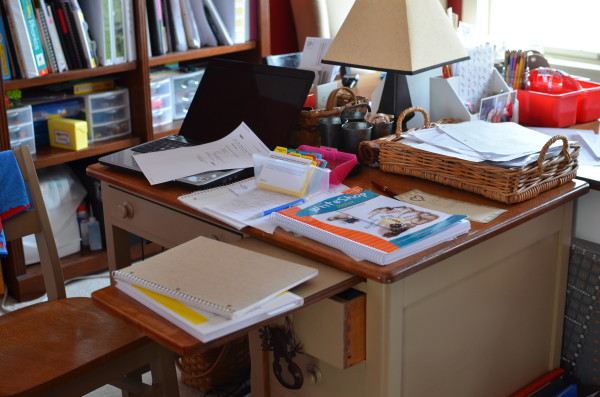
But there are beautiful moments in the midst of chaos. The books we’ve shared have become part of our family bond. We are the keepers of our schedule and can decide on priorities and be flexible to what suits our family best. My kids have the unique vantage point of being home to see that there is no fairy who cleans the house, stocks the fridge and puts away clean laundry while they’re at school so participation in chores is mandatory.
Myth #2 Homeschooled Children are Superchildren
Once my children were homeschooled, I was sure they would greet me in our schoolroom with glee each morning. “What will we be learning about today, Mother?” They would have extreme interest in every topic, and clap their hands when I broke out the grammar workbook. They would hug me and thank me and tell me I’m the best mother and teacher ever. They would cheerily do their schoolwork and help with chores, and of course never quarrel with each other. They would be National Spelling Bee champions, have perfect SAT scores, and attend college at 15.
The Reality about Homeschooled Children
- Well, it turns out that they are still children–my children–now that we homeschool. I wouldn’t say they greet me with glee every morning. I do often elicit a grin (or eye roll) with my favorite morning joke. {As soon as I hear the bus I yell out: “Kids! It’s the bus! Hurry or you’ll miss it!”}
- Sometimes their first question is phrased more like: “How much do we have to do today before we have free time?”
- I’ve had friends say they couldn’t homeschool because their children wouldn’t listen to them or their children would fight all day. And the truth is, sometimes our struggles aren’t over reducing fractions: they are about attitude.
- I’ve yet to hear one of my kids say, “Hey Mom, thanks for giving up hours a day so I can have an education tailored just for me.” I’m quite sure there are very few children who, as kids, are always grateful for the sacrifices their parents make for them.
But I am fully convinced that a focused education exactly at their level and catered to their learning style does help them reach their full potential. However, their strengths may not be in every traditional academic area. The real benefits I’m seeing aren’t about test scores but are found in children who are well-rounded with strong family and community ties, an ability to relate to all age ranges, time to pursue individual interest and talents, and the freedom to develop at their own pace. And when there are issues of the heart, who better than a me, their mother, to work through those issues with them?
I’m holding out for the thanks. I hope that someday, perhaps when they are parents, they’ll have some good memories of this homeschool life and give me my hug then.
Myth #3 Homeschool Moms are Superwomen
I was sure I would greet each day with a smile as sun streamed in my window and the birds serenaded me. I would be dressed and have an actual hairstyle when I skipped downstairs to tackle housework, diagramming sentences and meal planning (all at the same time). I would remain smiling, tender, and loving all day, helping each child in turn. I’d tuck them sweetly in to bed at night, curl up with a good book or turn my attention lovingly to my husband and fall asleep peacefully to enjoy a night of sweet dreams.
The Reality: Homeschooling is REALLY hard.
- It’s more like I stumble out of bed and head for the coffee maker. I hold up my hand to my early riser, who is attempting to engage me in a lively conversation about his weird dream last night, and mumble, “Mommy needs coffee first, buddy.”
- I lock the door when I shower or get dressed and sometimes spend a few extra minutes just hanging out so I can be alone. There are times I ask my kids to stop talking for a few minutes because I feel like my head is going to explode.
- I’ve learned a lot of hard lessons during the last two years–and one of them is that sometimes I’m the one with the bad attitude bringing down the school day. Or the one who didn’t clean up the dishes or fold the laundry when I should have–I must lead by example and often I fail.
- It’s hard not to get bitter or take any complaints or bad attitudes personally when I work so hard.
- I had a friend tell me she was surprised homeschooling suited me because she’d be pulling her hair out. The truth is that I often forget to use my soft, gentle voice. I’ve even threatened to send them to school. I daydream of dropping the kids off and having SIX HOURS to myself.
- Sometimes when bedtime comes I am talked and touched out and just want to be alone. And most nights my brain is firing away on some issue and I end up with odd dreams that are rooted in my anxieties.
The Reality of Homeschooling
When I make the joke about the bus, I’m truly grateful they aren’t on it. Whether I’m swelled with pride over what they’re accomplishing or requiring an assignment to be re-done because they didn’t do their best, letting them skip ahead because I know they understand or spending extra time going over a skill that isn’t solid yet, I’m so glad to be with them. We have deeper family bonds. I have reawakened (or discovered anew, I think) the joy of learning and love sharing the adventure with them. We have more control over our family’s priorities and more freedom to structure life to suit us. The tough parts only make us stronger.
Homeschooling isn’t perfect because we aren’t perfect. Those flaws my kids and I had before we started homeschooling? They’re still there. We’ve even noticed a few more as we spend all day together. It’s the hardest job I’ve ever worked at, and it looks like a long road ahead of us. I have to keep steady on our path, try not to trip or let the important things fall through the cracks, and keep my eye on our goals.
The bloggers of iHomeschool Network are sharing their stories of real-life homeschooling today. Comparison kills contentment, and we know it can be hard when you read blogs not to feel that other moms really have it together. As bloggers we try to share ideas, resources, and encouragement but want to make sure no one thinks any of us are perfect.
10 Things I’ve Learned Through Homeschooling
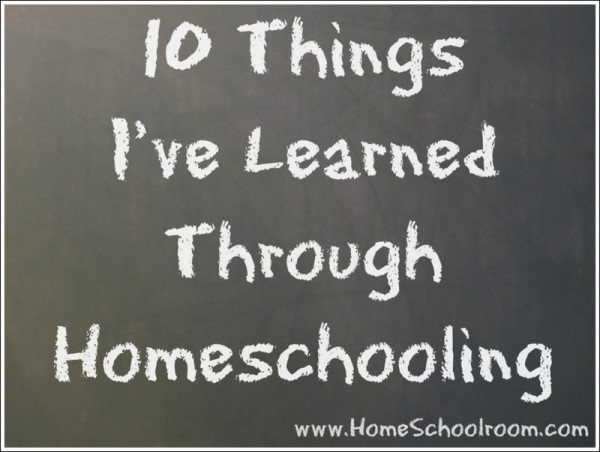
Homeschooling is the hardest job I’ve ever had. In the last two years I’ve learned a lot, and I don’t just mean catching up on history I never encountered or math I’d long ago forgotten. It has been like the refiner’s fire: the work of homeschooling sheds light on personality and relationship flaws. I have learned a lot about myself and my children, and when we use that information correctly it provides opportunities for deepening relationships and personal growth.
Here are the lessons homeschooling has taught me:
#1. Planning for homeschooling can be fun and overwhelming all at the same time.
I love making lists, choosing curriculum, and planning unit studies. Sometimes the planning can be more fun than the doing because the daily grind can make that flashy curriculum or involved unit study a chore. I’ve come to see that if I spend longer planning a unit than it takes us to go through it then I’m not managing my time wisely. There are also so many choices that I can get analysis paralysis and can’t choose. The internet is a wonderful resource but also full of differing opinions. I am finding it’s important to do my research reasonably, make an educated decision, then forge ahead to the best of my ability.
#2. You can take a good concept too far.
Working in organized units, grouping topics together, and working chronologically through topics is nice and tidy. Learning in themed units is something I love, but sometimes a little too much. I will hesitate to take advantage of a good resource because I’ll think we should save that for a full unit study. I get frustrated if we’ve finished a unit and I see another idea that would have gone with that topic. I try so hard to group everything together and work through topics methodically (and thus the planning that takes me forever, see #1). Charlotte Mason warns against making all the connections for your students, and I think I am in danger of this sometimes. I am finding my kids making fabulous connections on their own to books or topics we’ve studied months before. I am still working on loosening up on themes and taking it as it comes a little more.
#3. Simplifying is wise.
I struggle with this because I am the queen of over-complicating. I can’t seem to leave well enough alone with most curriculum or prepared unit studies. On one hand it’s good because I have no problem tweaking things to fit us, let alone the fact that I probably wouldn’t be homeschooling if I kept everything simple! On the other hand it has negative implications because I tend to over-think, over-research, and make things harder than they should be (see #1 and #2!). I am working one knowing when enough is enough and stop planning and fretting and just let things flow. Writing down my priorities and referring back to them is helping, as is gaining more experience so I can relax a little.
#4. The world is fascinating!
I was an A student all through school and college and a pro at doing what was necessary for the grade and then promptly dumping the information from my brain. I was not excited about the information or focused on the topics–I was focused on the grade. Now I’m finding I have an interest in everything: history, fine arts, nature study…it’s never too late to ignite a love of learning!
#5. Patience is a virtue that takes practice.
Unfortunately patience is not one of my natural strengths. Diligence and responsibility are, but patience? Not so much. I have zero patience with bad attitudes, dilly-dallying, silliness when it interferes with necessary tasks, having to repeat myself due to lack of paying attention, frequent reminders to pick up the Legos or dirty socks, loud or hyper behavior, interruptions when I’m talking or reading aloud… well, you know, things kids can be pretty prone to doing. I don’t often remember to use my gentle voice when reprimanding or reminding. The good news? Practice makes perfect. Homeschooling is stretching me in this area, God is coming along beside and equipping me, and we’re all learning and loving each other despite our imperfect natures.
#6. Lessons are learned best through example.
As I see behaviors I would like to change in them, I can often find a related problem in myself. I have to work on my own bad habits before I can address those of my children. Speak kindly and respectfully at all times. Do my work cheerfully. Pick up after myself and keep the house tidy. Again, loads of opportunity for personal growth and modelling that continual growth and effort to my children.
#7. It’s easy to forget to enjoy your kids when homeschooling.
I can be so focused on my goals and ever-growing to-do list that I forget to just spend time with my kids relaxing, having a (noneducational) conversation, or just looking at the clouds. It was a bit easier to just BE with them when I didn’t have their education on my mind 24-7. Should they be learning Latin? How can I incorporate more project-based learning and independence? Am I working with them enough on math or spelling or…? My mind reels and I forget that often what really matters is love and attention from me. This time will fly by, and as long as they love to learn and are prepared to learn their whole life it will all work out.
#8. Homeschooling isn’t like just being at home together, and it is hard work!
The mental drain of responsibility for their education and overseeing their daily tasks puts extra demands on the homeschooling parent. I’m an introvert, and the sheer amount of interaction and talking required wears me out most days. I realize that my style of homeschooling amplifies this–we read aloud a lot, work on subjects together, incorporate lots of hands-on activities, and shy away from worksheets. I’ve found ways to cope like daily quiet time. It took me a bit of time to realize the next lesson learned:
#9. You have to take care of yourself in order to do your job well.
Everyone uses the analogy of putting your oxygen mask on first so you can help your children. It is true–learn what you need to feel fulfilled and schedule it in. For example, I have learned I cannot skimp on sleep to get more done. Now, that’s not to say I don’t try when things are busy, but it is never a wise move. I suddenly become less productive and overly cranky. There are many other priorities for my mental health: time with my husband, time with friends, time for personal interests. I wrote about making time for things other than homeschooling, and shared techniques I learned over time to (try to) keep a balance in all things.
#10. Homeschooling requires a lot of time, energy, and sacrifice but it is worth it.
I’ve had to give up a lot of myself and my time to homeschool and it hasn’t always been easy. I sometimes complain or feel grumpy or longingly listen to moms who have hours a day to themselves. But most days I remember to be grateful we can set our family priorities. When we’re hiking on a gorgeous weekday, learning about a period of history all together, or getting extra time with Daddy I am overwhelmed with gratefulness.
Hop over to iHomeschool network to see what others have learned through homeschooling. Every Tuesday for the next 10 weeks I’ll be participating with the other bloggers of iHN in a blog hop of top ten lists.
This blog hop series was inspired by Angie of Many Little Blessings where you’re welcome to link up, too!
Reboot a Bad Day
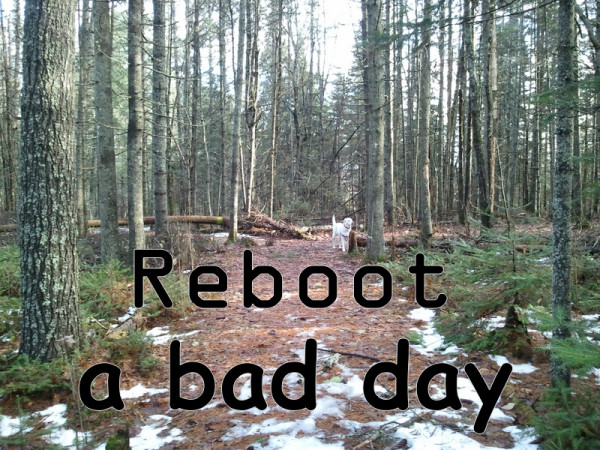
Yesterday was one of those days. Ever have those? It had started out well enough, and I had plans to get a lot of schoolwork done. But it seemed like the more I tried to tackle our list, no matter the subject or activity, the worse it went. By 1:00 we were all irritable and I had already given several stern lectures.
No one was happy, and I dare say no one was learning anything.
My first impulse was to send them up to their rooms and spend an afternoon completely alone…not really productive. There were still hours left until bedtime so I really needed to fix the mood of the day. We needed a reboot–a way to give us a completely fresh start midway through a day.
I told them to get ready, we were heading to the woods. It wasn’t great weather: warmer than usual, but very windy, and instead of sparkling snow there was only mud and dead grass. But I know time in nature is like medicine. I don’t reach for it as often as I should, or I go by myself for time alone, but everyone must go or it isn’t effective. I can return to the house and catch a bad attitude again very quickly.
We walked, ran, explored and laughed at our dog gleefully tromping through every wet spot she could find. We returned from the fresh air renewed and refreshed.
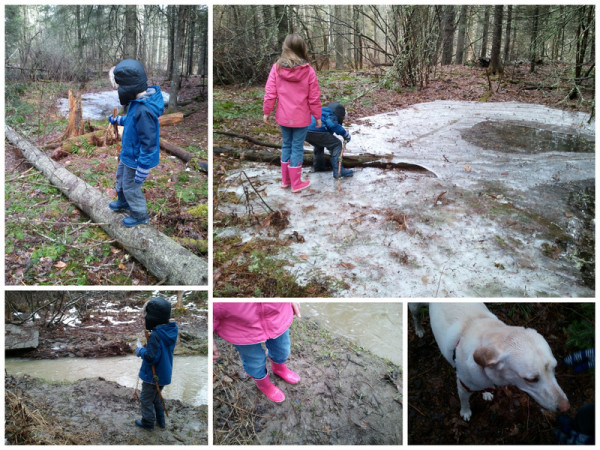
At home we settled in the living room to listen to an audiobook. As always we became caught up in the story and the afternoon passed happily away as our hands busily worked on different things: my son played in sand and built with Legos, my daughter drew, and I cut fabric for a project we’ll be doing together. The day ended happily and productively.
My original plan was not completed, but I’m sure we’ll fit those activities in another day. Better to do them later than to do them and have the reason for doing them lost. I am a list-maker, I love to cross things off my list, and I can also be quite stubborn. Sometimes on bad days I push ahead, forcing my plan on the day. But I am convinced that on those really bad days if I forge ahead no real learning will take place. They won’t remember the information, experiment, or activity if it’s done with a cloud of crankiness over us all.
Try a reboot when you’re having one of those days. You may have many items left on your list, the weather may not be perfect, and you may even need to drive to find a peaceful spot, but you may find it is just what you need to restart the day.
My Interview for the “Who Homeschools?” Feature
Savannah from Hammock Tracks asked me a few questions for her “Who Home Schools?” interview series. I had fun answering the questions about how and why we homeschool and sharing my goals and concerns.
Stop by Hammock Tracks to check out my interview and find out what my favorite…and least favorite…part of homeschooling is.
Have Some Gooey Fun with Homemade Slime
The kids and I had to have a little fun on Halloween. We don’t enjoy the scary, gory side of Halloween, but a little slime is a lot of fun. This recipe came from my son’s preschool teachers.

Ingredients:
- 8 ounces of Elmer’s Glue (must be Elmer’s)
- 1 cup cold water
- 1/2 cup hot water (not boiling)
- 1 tablespoon Borax
- food coloring
Directions:
- Mix the cold water and glue in a mixing bowl.
- In a separate bowl mix Borax and very hot water. Stir well until the Borax is dissolved.
- Add about 10 drops of food coloring to the Borax mixture. (For fun you can also add glitter now.)
- Slowly add the Borax mixture to the glue mixture. Stir with a spoon for just a few seconds, then immediately mix with your hands. In less than a minute you’ll have a gooey, non-sticky, stretchy material.
- Store in an airtight container. Refrigerate when not using and it will keep for several weeks.
Have fun sinking your hands into this gooey, slimy concoction. It is icky and fun all at the same time. It’s fun to give as a little non-sugary treat, too. We’re bringing some to our friends today!
It will take on a shape for a moment…

then slowly

ooze back into a wobbly lump.

Happy Halloween!
Letterboxing: Treasure Hunts in Nature
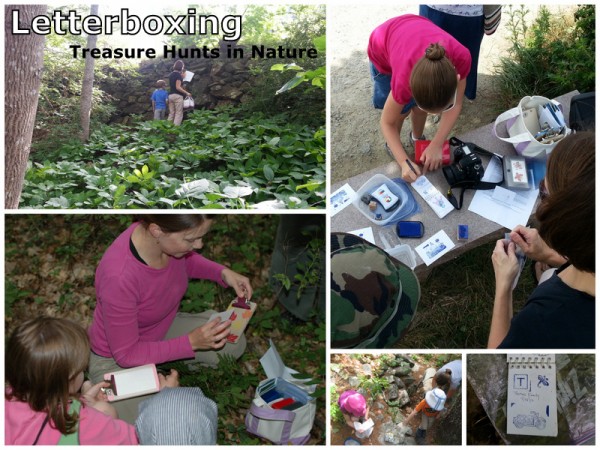
We first tried letterboxing a couple years ago and after our first box we were hooked! What is letterboxing, you ask? It’s like a treasure hunt! You follow clues to find a carefully hidden box. The best parts: it’s free, easy, a hobby multiple ages can enjoy, and encourages time in nature. If you want to try letterboxing, just follow these three simple steps:
Get Ready
The supplies are inexpensive and easy to put together:
- A small notebook or index cards. I prefer index cards because we can bring extras in case we smudge a stamp. If you use index cards you’ll also want a box to hold them.
- A stamp for your “signature” once you find the letterbox. Right now the kids and I each chose a store bought rubber stamp, but my goal is for us to make custom stamps (more on this later).
- An ink pad. Sometimes there is one you can use inside the letterbox, but they’re often dried out so it’s better to come prepared.
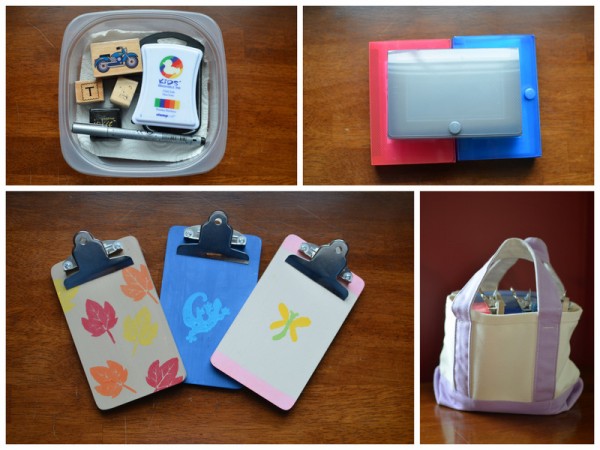
As we’ve developed this hobby I’ve added some organization and fun: I bought small wooden clipboards for $1 each at AC Moore and we painted them. Since there often isn’t a flat surface nearby we can put our index card on the clipboard and get a good impression of the letterbox stamp. We keep our supplies tucked into a little tote bag that is ready to grab and go.
Get Clues
I use Atlas Quest, an online letterboxing community. You can search for letterboxes by putting in your location and how far you’re willing to travel. You’ll see the name (which can be simple like “Lamoine State Park” or more creative like “Birds of a Feather”) and general location (the town, park, or closest building). The handy pictures under “attributes” let you know details, like whether it’s pet friendly or how long a hike it is from a parking area to the box. Once you click on the name you’ll see more details about that letterbox and then you can click to get the clues.
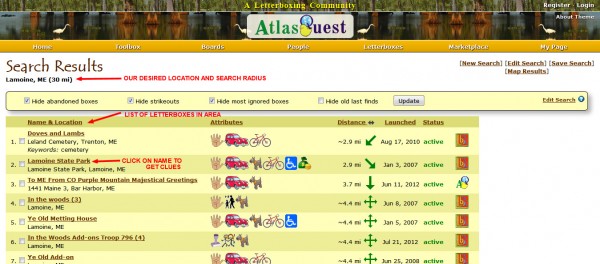
You follow the clues to the box: directions like looking for a certain tree, rock formation or other landmark, facing a certain direction, taking X number of steps, etc. With letterboxing you don’t need a GPS device like you do with geocaching.
Find the Letterbox
At the end of the clues you search a bit, and the moment you see the box is exciting! Open it and you’ll find a unique stamp, usually hand carved, and a log book. You stamp your signature stamp in the log book, then stamp that letterbox stamp on your book or index card as a memento. Often geocaches have trinkets you can exchange, which takes a little more prep-work to bring trinkets to trade. Then there’s the chance that both kids want a certain trinket and it causes a disagreement. With letterboxing it’s just a stamped image for everyone. My kids are very excited to see the stamp because the hand-carved stamps are often very creative. I won’t include a photo of one because that’s kind of like telling the end of a good book!
Letterboxing has become a wonderful shared hobby for our family. We spend time together in nature, we don’t have to do a lot of planning or spend a lot of money, and we all enjoy it! An extra bonus is that although we’ve looked for letterboxes in many of our favorite spots, we’ve also been to new places when following the trail of a letterbox.
We have a goal of learning to hand carve stamps so we can make custom signature stamps. Atlas Quest has good information, and I love this great photo tutorial from Wee Folk Art on making stamps. Once we master that we’d like to place our own letterbox for others to find. Coming up with a location and name, unique stamp and directions, and then checking back to view the log book would be a great challenge.
Have I convinced you yet? Fall is a great time to try letterboxing!
The Best Way to Garden with Kids
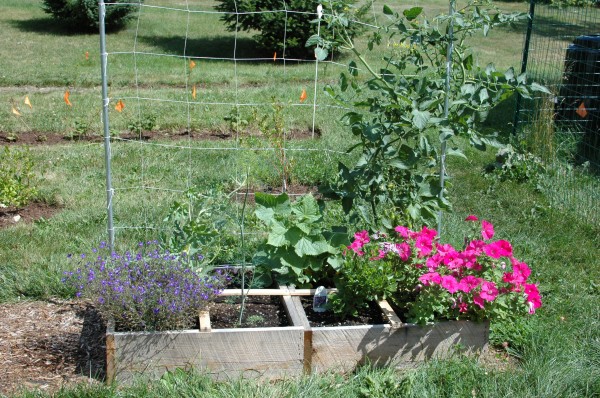
I enjoy gardening and wanted to share it with my kids. Why? Well, it gives them a connection to nature and where their food comes from. It’s another chance to teach a little work ethic and responsibility and the rewards that come with following through. Then there are the science lessons learned in the real world with a hands-on activity that is a lifelong interest for many people. So, have I persuaded you to give it a try with your children yet?
Right about the same time my kids were the perfect age to start gardening I discovered my favorite way to grow vegetables, Square Foot Gardening. Square Foot Gardening (SFG) has allowed me to have the most success in vegetable gardening with the least amount of work. If you’ve not heard of it, visit the Square Foot Gardening website. Their website is loaded with information, and then if you’re really interested I would read Mel Bartholomew’s most recent SFG book. In short, Square Foot Gardening is raised bed gardening in an easy-to-make soilless mix with the space divided by a grid into one foot squares. It cuts down on weeds and watering and is incredibly easy to manage.
Now for the part about gardening with kids: Square Foot Gardening is also (in my humble opinion) the best way to garden with kids for two main reasons:
#1. They get their own garden space. This is much more exciting and motivating than helping Mommy weed her garden. They get to choose what to plant. Being able to make the choices has been paramount in holding my kids’ interest. However, with this right comes the responsibility to weed and water their plants. You could give a very small child one square; my children each get four squares to call their own. We start daydreaming of what to put in our squares as soon as the seed catalogs arrive. We talk about the successes and failures of previous choices. We determine which items would need to be directly planted by seed into the garden and which would need to be started before the season. My girly-girl wants to grow mostly flowers, and that is okay. It’s her spot to plant as she wishes!
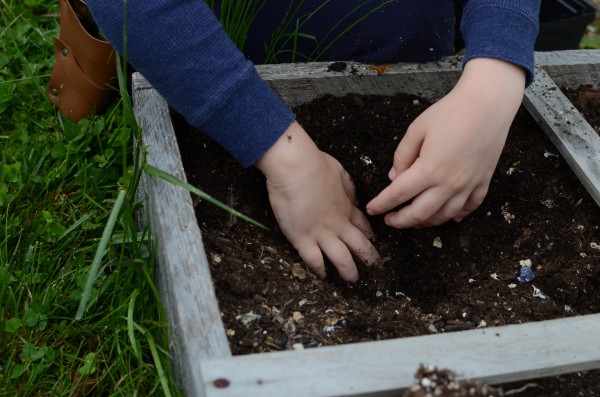
#2. They truly can do all the work for their garden on their own. The soilless mix is divine. Year after year it stays loose and easy to work with, able to be mixed simply with your hands (my son’s choice) or a small garden trowel (my daughter’s preference). Planting is easy because of this, and so is weeding. Since you aren’t starting with weed seeds in your mix you get very few weeds anyway, and the ones you do are easy to pull out with an gentle tug, root and all (you can see the tiny weed my son pulled and it’s long root in the photo below). The grid involved in square foot gardening is the key here: with it even young children can see which is the plant and what are weeds.
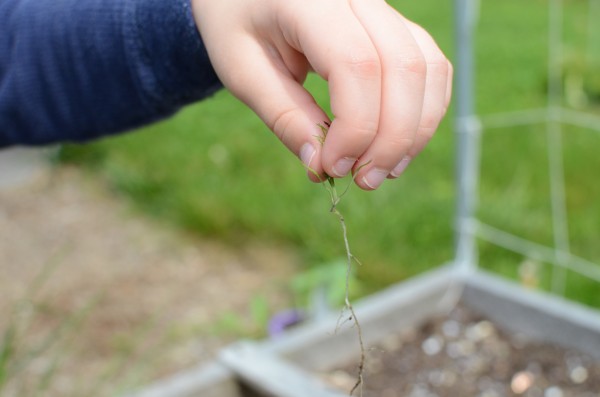
This is our third year gardening with Square Foot Gardens, and I am still in love with it. It makes gardening manageable and fun, and my children take great pride in their squares. I’ll never forget the night we had dinner with another family and my daughter could proudly say that she grew the tomatoes for the salad!
